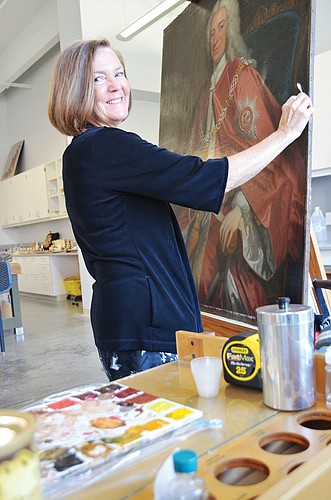- November 25, 2024
-
-
Loading

Loading

Barbara Ramsay stood on scaffolding high above the floor of the Sistine Chapel. The tip of her nose was mere inches away from Michelangelo’s famous mural. She could see his confident brush strokes.
Ramsay, the new chief conservator of The Ringling Museum, was visiting the Sistine Chapel when her fellow conservators were treating the ceiling. She uses the same process in her own job that they used to restore the chapel.
She watched as the conservators removed candle soot from the mural, unveiling a completely new interpretation. For hundreds of years, the Sistine Chapel’s color tones led art historians to believe Michelangelo preferred a dark and muted color palette. But it turned out that the candle soot needed to be removed to see what Michelangelo had intended. Conservation completely changed the historic interpretation of his artwork.
Art conservators use a combination of science and art to restore pieces back to the way they were when the artist painted them. They also treat the pieces so they will stay preserved well into the future.
As an art conservator with more than 40 years of experience, Ramsay would have loved to get her handmade cotton swabs on the Sistine Chapel’s ceiling. Nevertheless, she enjoyed the front-row seat watching as the conservators worked — just one perk of her job.
Ramsay’s job is also about preserving art for this generation and future generations to enjoy. It’s detailed but exciting work.
For instance, for nine of the 15 years she worked at ARTEX Fine Art Services in Washington, D.C., she helped conserve 300 abstract expressionist works by Clyfford Still. She and her team unrolled and worked on pieces the public had never seen. She hasn’t yet had a chance to really dig into works at The Ringling like she did at her last job.
Ramsay has only been employed here for three months and has a lot of work ahead of her.
She’s doing everything from hiring a team, to treating pieces going on loan and even checking climate control and systems of the buildings. Right now, she’s working on a new acquisition for The Ringling’s permanent collection — an 18th century portrait by Allan Ramsay (of no relation).
 She thoroughly examines the piece to look for signs of deterioration and its causes, then works out the best treatment plan. This requires a lot of careful testing — the kind of work that involves microscopes, tiny watercolor brushes and testing solvents to find the perfect mixture.
She thoroughly examines the piece to look for signs of deterioration and its causes, then works out the best treatment plan. This requires a lot of careful testing — the kind of work that involves microscopes, tiny watercolor brushes and testing solvents to find the perfect mixture.
From there, she’ll remove the varnish. She’ll heat and humidify the places where there are bulges and deformations. But, generally speaking, this piece is in good shape. When they’ve been in worse condition and she has removed varnish or dirt (using hundreds of handmade cotton swabs) she’s uncovered gems such as original signatures.
There will be a distinct difference between before and after on this piece. The varnish is causing a yellowish tint, which she will remove. There will be more of a contrast in the colors. The deformations will be almost erased. It’s the kind of work you don’t think about when viewing the art.
Varnish removal and inpainting can take anywhere from a couple of days to a few months. But it’s not tedious, because she enjoys the meticulous attention to detail.
“When you’re a conservator you’re focused,” she says. “You can do damage with almost anything, so you have to be completely in control. But there’s a zen to it. It’s really satisfying because you’re making something look so much better.”